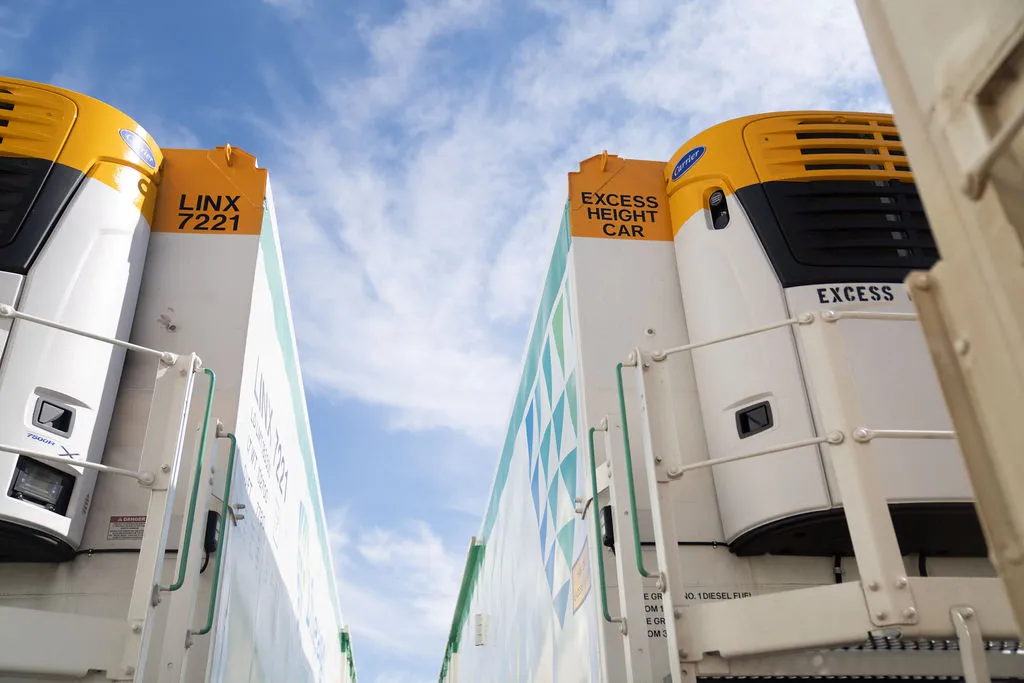Shipping frozen goods presents unique challenges that demand precise control over temperature, timing, and handling to ensure freshness and safety. Whether you’re transporting frozen food products, pharmaceuticals, or other perishable items, maintaining the cold chain from origin to destination is critical. As supply chains grow increasingly complex, smart shippers are turning to intermodal transportation as a trusted solution for shipping frozen goods efficiently, reliably, and cost-effectively in 2025.
In this comprehensive guide, we will explore the five essential reasons why shipping frozen goods using intermodal freight is the smart choice for businesses looking to protect product integrity while optimizing logistics operations.

Understanding the Complexity of Shipping Frozen Goods
Before diving into the advantages of intermodal shipping, it’s important to recognize the inherent complexity involved in shipping frozen goods. These products require consistent low temperatures—often below freezing—throughout transit, storage, and handling to prevent spoilage and contamination. Temperature fluctuations can cause irreversible damage, compromising quality and safety, leading to costly losses and regulatory penalties.
Traditional single-mode shipping methods, such as trucking alone, can sometimes struggle to maintain strict temperature controls over long distances or in changing weather conditions. This is where intermodal shipping for frozen goods offers significant benefits by combining the strengths of multiple transportation modes and specialized refrigerated equipment.
What is Intermodal Shipping and How Does It Work for Frozen Goods?
Intermodal shipping involves moving freight using two or more modes of transportation—commonly rail, truck, and sometimes ocean or air—without unloading the cargo from its container. For shipping frozen goods, this approach typically uses refrigerated containers (reefers) that remain sealed and temperature-controlled throughout the journey, regardless of the transport mode.
This multi-modal system allows shippers to leverage the cost-efficiency and environmental benefits of rail for the long-haul portion of transit, while trucks provide the vital flexibility of last-mile delivery. For frozen goods, maintaining a sealed, temperature-controlled container during these transfers is key to preserving product quality.
Reason 1: Superior Temperature Control and Cold Chain Integrity
One of the primary reasons to choose intermodal shipping for frozen goods is the unparalleled ability to maintain precise temperature control throughout the entire supply chain. Reefer containers used in intermodal transport are equipped with advanced refrigeration systems that keep frozen goods at consistent, optimal temperatures.
Unlike traditional shipping that may require unloading and reloading or multiple temperature adjustments, intermodal shipping allows the refrigerated container to stay sealed and powered continuously. This reduces the risk of temperature abuse, which is one of the leading causes of spoilage in frozen freight.
Rail yards and intermodal terminals are increasingly equipped with the infrastructure to support reefer containers, including plug-in stations that keep containers refrigerated during loading and unloading, further ensuring cold chain integrity.
Reason 2: Cost-Effective Long-Distance Shipping for Frozen Goods
Shipping frozen goods over long distances can be costly due to the specialized equipment and strict handling requirements. Intermodal shipping provides an economical alternative by combining the low-cost efficiency of rail for the bulk of the journey with the flexibility of trucks for first and last-mile delivery.
Rail freight is inherently more fuel-efficient than trucking over long distances, translating to significant savings on transportation costs. When combined with refrigerated containers, intermodal shipping offers a cost-effective solution for shipping frozen goods across Canada, the United States, and beyond without compromising temperature control or delivery schedules.
Reason 3: Enhanced Reliability and Reduced Risk of Delays
Shipping frozen goods demands not only strict temperature management but also reliable transit times. Delays in frozen freight shipments can lead to thawing, spoilage, and lost revenue. Intermodal shipping improves reliability by reducing dependency on a single transportation mode and taking advantage of the strengths of each.
Railways operate on dedicated tracks and are less impacted by road congestion, weather disruptions, or driver shortages that frequently delay trucking shipments. By combining rail with trucks strategically, shippers can optimize routes to avoid bottlenecks and improve on-time delivery rates, essential for sensitive frozen goods.
Additionally, intermodal carriers provide real-time tracking and monitoring, offering visibility into shipment status and container temperatures. This transparency allows for proactive responses to any potential issues, ensuring frozen goods arrive fresh and safe.
Reason 4: Environmentally Sustainable Shipping for Frozen Goods
In 2025, environmental responsibility is more important than ever for shippers and consumers alike. Shipping frozen goods via intermodal transport helps reduce carbon emissions compared to relying solely on trucking.
Rail transport produces significantly less greenhouse gas emissions per ton-mile than trucks, making intermodal shipping an eco-friendlier option for frozen goods. Companies that prioritize sustainability benefit not only from lower environmental impact but also from improved brand reputation and compliance with emerging green regulations.
By choosing intermodal shipping, businesses contribute to a greener supply chain while maintaining high standards for frozen goods transport.
Reason 5: Scalability and Flexibility for Complex Frozen Goods Supply Chains
Frozen goods supply chains often involve multiple stops, storage points, and varying delivery schedules. Intermodal shipping offers unmatched scalability and flexibility to accommodate these complex logistics requirements.
The use of standardized reefer containers allows frozen goods to be transferred seamlessly between transportation modes without repacking or exposing the cargo to environmental risks. This makes it easier to scale shipments up or down depending on seasonal demand or changing market conditions.
Intermodal networks also enable shippers to access a broader range of geographic locations efficiently, combining rail corridors for long hauls with trucking networks for remote or urban deliveries. This flexibility ensures that frozen goods reach their destinations on time, maintaining quality from origin to customer.
Summary: Why Intermodal Shipping is the Future for Shipping Frozen Goods
In summary, shipping frozen goods in 2025 requires a sophisticated, reliable, and temperature-controlled approach that intermodal shipping uniquely provides. By combining superior cold chain integrity, cost savings, enhanced reliability, environmental sustainability, and operational flexibility, intermodal freight is the go-to solution for modern frozen goods logistics.
Choosing intermodal shipping ensures your frozen products maintain freshness and safety while optimizing your supply chain costs and environmental impact. As the demand for temperature-controlled logistics grows, intermodal solutions become even more vital to meeting customer expectations and regulatory compliance.
For shippers looking to elevate their frozen goods shipping strategy, understanding the benefits of intermodal freight is the first step toward smarter, hassle-free logistics in 2025.

What Are Intermodal Reefers?
Refrigerated containers—commonly known as intermodal reefers—are designed specifically for shipping frozen goods and other temperature-sensitive cargo. These containers are equipped with advanced refrigeration units that maintain a constant internal temperature, powered by the rail network’s electrical systems.
Used across industries like food and beverage, pharmaceuticals, and chemicals, intermodal reefers are essential for transporting perishable items such as seafood, meat, dairy products, and frozen produce. By keeping the temperature within a safe range, these containers ensure frozen goods arrive in perfect condition.
Common Misconceptions About Shipping Frozen Goods by Rail
A common myth is that rail freight is too slow or unreliable for shipping frozen goods. This couldn’t be further from the truth. In fact, shipping frozen goods by intermodal rail is one of the fastest-growing methods in Canada.
Understanding how reefer intermodal freight works helps businesses optimize for cost and quality control.
Types of Shippers in Frozen Goods Transportation
When it comes to shipping frozen goods, there are three main types of shippers:
- Load and Cool: Products are loaded fresh and cooled during transit.
- Load and Go: Frozen goods are loaded, and the reefer reaches optimal temperature en route.
- Wait for Temperature: Products are loaded only after the reefer hits the exact required temperature.
Each method impacts transit timing and pricing. Shippers who choose “Wait for Temperature” often incur driver wait fees—but get precise temperature control before loading.
How Intermodal Reefers Work
Refrigeration units in these containers function using a compressor and refrigerant loop to extract heat. The system constantly monitors and adjusts cooling levels to maintain the set temperature.
This level of control is vital for shipping frozen goods safely across long distances without spoilage or quality loss.
Real-World Uses of Intermodal Reefers for Shipping Frozen Goods
1. Seafood Restaurants
Fresh fish doesn’t stay fresh without precise cooling. Intermodal reefers allow seafood distributors to move frozen goods from the coast to inland restaurants with confidence.
2. Grocery Delivery Services
Retailers rely on refrigerated transport to move frozen products directly to distribution centers or homes without compromising quality.
3. Pharmaceutical Companies
Many medications must be kept within strict temperature ranges. Intermodal reefers help meet compliance and safety standards when shipping frozen goods like vaccines or biologics.
4. Fine Art Galleries
Art can be considered a temperature-sensitive item. Reefers maintain stable environments to protect pieces from heat or humidity during transport.
Benefits of Shipping Frozen Goods by Intermodal Reefer
✅ Cost Efficiency – Intermodal shipping is often more affordable than full-truckload reefer transport, especially over long distances.
✅ Environmental Advantage – Trains emit up to 75% less greenhouse gas than trucks per ton-mile, making intermodal a greener option for shipping frozen goods.
✅ Secure and Reliable – Rail yards offer higher security, and less handling reduces the risk of product damage or theft.
✅ Scalable Logistics – Whether shipping frozen goods seasonally or year-round, intermodal solutions adapt to your business’s volume.
✅ Final-Mile Flexibility – With integrated drayage, intermodal reefer freight ensures your goods make it all the way to their final destination, cold and intact.
Key Considerations for Reefer Shipping Logistics
Keep in mind that most rail carriers require reefer containers to be emptied and returned within 24 hours of unloading. This might mean scheduling weekend deliveries to avoid penalties.
If you’re planning to start or scale your shipping of frozen goods, knowing these rules can help you stay compliant and avoid unnecessary fees.
Conclusion: Keep It Cool, Ship It Smart
As we have explored throughout this guide, shipping frozen goods is a highly specialized and critical part of the modern supply chain. Maintaining strict temperature control, ensuring timely delivery, managing costs, and minimizing environmental impact are all top priorities for shippers handling frozen freight. In 2025, intermodal shipping stands out as the most comprehensive and reliable solution to meet these challenges head-on.
The Indispensable Role of Intermodal Shipping in Frozen Goods Logistics
When you choose intermodal shipping for frozen goods, you’re opting for a transportation method that expertly balances multiple factors that are vital for success. From the superior temperature management capabilities of refrigerated containers to the cost savings enabled by combining rail and truck transport, intermodal freight offers unparalleled advantages.
Maintaining the cold chain integrity throughout the journey is non-negotiable when shipping frozen products. Intermodal shipping keeps reefer containers sealed and continuously powered, drastically reducing temperature fluctuations and spoilage risks compared to traditional single-mode transport. This results in fresher, safer frozen goods arriving at their destination, protecting your brand reputation and customer satisfaction.
Maximizing Cost Efficiency Without Sacrificing Quality
Cost considerations are paramount in any shipping decision, especially for temperature-sensitive frozen goods. The fuel efficiency and scalability of rail transport in intermodal shipping translate directly into lower freight costs. By leveraging rail for the long-haul portion of transit, combined with trucks for first and last-mile delivery, shippers can enjoy significant savings without compromising the quality or safety of their frozen shipments.
Intermodal shipping also offers flexibility in shipment sizes, enabling businesses to scale operations according to seasonal demand or changing market dynamics. This adaptability ensures that you only pay for the capacity you need, making shipping frozen goods more economical than ever before.
Reliability and On-Time Delivery You Can Count On
Time is of the essence when shipping frozen goods. Delays and disruptions not only increase operational costs but also risk thawing and spoilage, which can devastate product quality. Intermodal shipping mitigates these risks by capitalizing on the reliability of rail transport, which is less susceptible to traffic delays and driver shortages compared to trucking alone.
Additionally, intermodal providers often offer advanced tracking and temperature monitoring technologies, giving shippers real-time visibility into the location and condition of their frozen goods. This proactive approach enables swift responses to any potential issues, ensuring your shipments remain on schedule and intact.
Embracing Sustainability in Shipping Frozen Goods
Sustainability is no longer optional for forward-thinking shippers. Intermodal freight shipping presents an environmentally responsible way to move frozen goods by reducing greenhouse gas emissions and lowering the carbon footprint of your supply chain.
Rail transport emits significantly less CO2 per ton-mile compared to trucks, making it the greener choice for long-distance frozen freight shipments. By choosing intermodal shipping, your business not only contributes to protecting the environment but also aligns with growing consumer expectations for eco-friendly practices.
Partnering with Industry Experts Like RailGateway for Optimal Results
Successfully navigating the complexities of shipping frozen goods requires expertise and reliable partners. RailGateway specializes in providing tailored intermodal solutions designed to optimize cold chain logistics. With extensive experience in refrigerated container shipping and an expansive network across Canada and North America, RailGateway ensures your frozen goods are handled with the utmost care and efficiency.
From route planning and equipment selection to temperature monitoring and on-time delivery, RailGateway’s intermodal experts offer end-to-end support to make your frozen freight shipping hassle-free. Whether you’re new to intermodal shipping or looking to enhance your current operations, RailGateway provides customized strategies that save you time, money, and stress.
How to Get Started with Intermodal Shipping for Frozen Goods
If you’re ready to improve your frozen goods logistics with intermodal shipping, RailGateway is here to help. Visit railgateway.ca to request a free quote or speak directly with one of their knowledgeable intermodal experts. They will assess your specific shipping needs and design a solution that guarantees cold chain integrity, cost savings, and reliable delivery.
The future of shipping frozen goods lies in smart, integrated transportation solutions that combine technology, efficiency, and sustainability. By partnering with RailGateway and choosing intermodal shipping, you position your business to thrive in today’s demanding logistics landscape.
Final Summary: Why Intermodal Shipping is Essential for Frozen Goods in 2025
- Unmatched Temperature Control: Reefer containers stay sealed and powered, protecting frozen goods throughout transit.
- Cost Efficiency: Rail combined with trucking lowers transportation costs for long-distance frozen shipments.
- Reliable Transit Times: Rail avoids road congestion, reducing delays and maintaining cold chain integrity.
- Sustainability: Intermodal shipping significantly cuts greenhouse gas emissions compared to trucking alone.
- Flexibility and Scalability: Easily adjust shipping volumes and routes based on changing demand.
- Expert Support: RailGateway offers comprehensive intermodal services tailored for shipping frozen goods.
For any business serious about optimizing their frozen freight supply chain, intermodal shipping is the essential solution in 2025. Reach out to RailGateway at railgateway.ca and discover how you can make your frozen goods shipping smarter, safer, and more cost-effective today.

Additional Resources:
EPA Freight Emissions Comparison
Government of Canada: Guide to Safe Food Transport
Canadian Food Inspection Agency: Temperature Control
FAQ
1. What are the main benefits of shipping frozen goods using intermodal transport?
Shipping frozen goods with intermodal transport offers superior temperature control, cost savings, and improved reliability. It combines the efficiency of rail for long distances and trucking for first/last-mile delivery, maintaining cold chain integrity. This method reduces risks of spoilage while optimizing shipping costs.
2. How does intermodal shipping ensure the safety of frozen goods?
Intermodal shipping uses refrigerated containers (reefers) that keep frozen goods at consistent temperatures throughout transit. The containers remain sealed and powered, preventing temperature fluctuations that cause spoilage. Rail transport’s reliability also minimizes transit delays that could jeopardize product quality.
3. Can intermodal shipping help reduce overall shipping costs for frozen goods?
Yes, intermodal shipping significantly reduces costs by leveraging the fuel efficiency and economies of scale of rail transport for the long-haul portion. Trucking handles shorter distances efficiently, providing a cost-effective balance while ensuring the frozen goods remain intact.
4. Is intermodal shipping environmentally friendly for frozen goods?
Absolutely. Intermodal shipping lowers carbon emissions by shifting most of the freight haul to rail, which has a smaller environmental footprint than trucking alone. This greener approach supports sustainability goals while ensuring safe transport of temperature-sensitive frozen products.
5. What kinds of frozen goods are best suited for intermodal shipping?
Intermodal shipping is ideal for a wide range of frozen goods including food products like seafood, meats, vegetables, and pharmaceuticals requiring strict temperature control. The versatility of reefer containers makes it suitable for any frozen cargo needing reliable cold chain management.
6. How does RailGateway support shippers with frozen goods logistics?
RailGateway offers expert guidance, tailored intermodal solutions, and access to refrigerated container shipping networks. Their team ensures optimal route planning, temperature monitoring, and on-time delivery, helping shippers save money and reduce risk when shipping frozen goods.
7. What are the challenges of shipping frozen goods using intermodal transport?
While intermodal shipping offers many benefits, challenges include coordinating multiple carriers, ensuring continuous power supply to reefers, and managing transit times. Partnering with experienced providers like RailGateway can mitigate these risks and streamline the process.
8. How can I track my frozen goods during intermodal shipping?
Many intermodal shipping providers offer advanced tracking systems with real-time GPS location and temperature monitoring. This visibility helps shippers ensure the frozen cargo remains at safe temperatures and arrives on schedule, reducing spoilage risk.
9. Is intermodal shipping faster than traditional trucking for frozen goods?
Intermodal shipping may not always be faster in terms of transit time, but it is generally more reliable and consistent. Rail is less affected by traffic and driver shortages, which helps frozen goods maintain cold chain integrity by reducing unexpected delays.
10. How do I get started with intermodal shipping for my frozen goods?
To start shipping frozen goods via intermodal, contact experienced logistics providers like RailGateway. Visit railgateway.ca for a free quote and consultation to develop a customized shipping plan that fits your cold chain and budget requirements.





